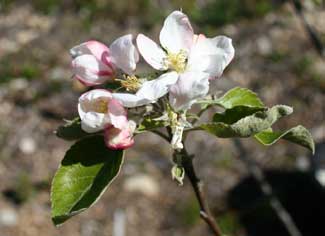
Granny Smith Apple
"Church bells will chime
You will be mine
In apple blossom time."
-Neville Fleeson,
1920
1920
When I was a child, I'd often spend the night over at Grampa & Grandma's. Their house was built when my mom was a kid, & that was when Grandma Elva planted her apple trees & Italian prunes.
She planted a Granny Smith right next to the house. It was allowed to grow into a big sprawling tree, rarely if ever pruned, so by the time I came along I had the definite impression that apple trees were gigantic. It was not so much tall as very wide, with twisted leaning trunks in three directions easy to climb on & sit on.
I didn't quite kn0w why Grandma called the tree 'Granny Smith,' so to me it was just the tree personified as one more grandmother. The idea that trees would have personifying names was as natural as Grandma Elva's biggest cooking pot being named Mable, & any one of us grandkids being told, "Run over to grandma's & ask to borrow Mable." It was actually a little disconcerting when iI eventually learned there were many more granny-trees than Grandma's.
If I wanted to get out of Grandma's house without anyone knowing I'd gone outside, I'd climb out the bathroom window onto a Granny Smith limb & climb down to the ground. Between being part of my secret exit, & Grandma Elva's apple pies made from its apples, I could not help but acquire a sentimental fondness for the variety, which has lasted me for life.
The Granny Smith apple is named for its original discoverer, Mary Ann Smith (1799-1870) of Eastwood (now part of Ryde, a municipality of Sydney) in New South Wales. She was born Maria Ann Sherwood in Peasmarsh, Sussex. She married a farm worker, Thomas Smith, & in 1838 they caught the Lady Nugget & emigrated to Australia.
In 1868 Mary found the tree fruiting in an area where she had many years before discarded some old apples. She was able to market apples from this tree, but died two years later, & Tom seven years after that, & they never suspected how popular the family's productive tree would become.
It fell to local orcharders to further develop her tree. It reached the gardens of the general public beginning in 1890. In Ryde today, Mary & Tom's farm has become the Granny Smith Memorial Park. Every October Ryde puts on a Granny Smith festival.
Folklore, & apparently Marie Smith herself, has insisted this apple is a larger-fruited sport of her French crabapple Malus sylvestris, accounting for its tartness. Many ammend this to the idea that the first Granny Smith tree was hybridized with the French crabapple, but certainly is not M. sylvestris per se. It's much more certainly derived from M. pumila (aka, M. communis, M. dasphylla, or M. domestica) & that first Granny Smith tree was almost certainly a seedling of 'Newton Pippin,' an antique variety originally developed in New York in the early 1800s. M. pumila cultivars taken collectively make this species the world's most common fruiting tree, grown in all temperate zones, with the pomes marketed just about everywhere on earth.
The fruit is a shiny apple-green pome with occasional blushes of pink. Tart & crisp, Granny Smiths are regarded as good eaten fresh from the tree, or as a salad-apple, & is even better for baking or for chutneys. It is a popular commercial apple because it stores easily for long periods, marketable year round.
Not everyone knows how good a Granny Smith can be, since they are so often shipped far from the main commercial growers in New Zealand or Washington state, & stored too long in serial locations passing through the hands of middlemen before reaching store shelves. Along their route they're not always kept at an ideal temperature to preserve freshness as long as might've been.
So by the time someone actually tries to eat one, it has become grainy & lost its signature crispiness. To test out-of-season Granny Smiths, rub the skin to see if it wrinkles; if it does, it was not stored at the right temperature. Also if it has any brown spots or discoloration especially around the stem, it is just too old to be good for much; if it is either fresh, or properly stored for sale in other seasons, it will not have spots.
The tree flowers mid-April. The fruit ripens in September & October, but is frequently harvested prematurely (in August) to maximize tartness & storability. The young bareroot sapling which I installed spring of 2005 at a friend's garden began that very year to produce a few token apple, but was ornamentally exciting immediately with April apple blossoms. Within three years it was producing nicely for such a young tree.
Modern apples including 'Granny Smith' are grafted onto semi-dwarf rootstock but grow to be substantial trees even so, & need seasonal (late winter) pruning if they are to remain smallish. There are also Granny Smith trees available on fully dwarf rootstock, but these usually require staking for their entire lifespan, so are not recommendable for ornamental double-duty, unless you're expert at trainign them to espaliers.
Granny Smith is not a self-pollinating apple tree, & requires a partner for cross-fertilization. Growing near Granny, therefore, is another popular variety, 'Fuji.'
Both Fuji & Granny Smith are in the top-ten most popular apples in America, though the number one apple, Washington Delicious, is all looks & not that tasty, & the number two apple, Golden Delicious, quickly goes soft & grainy, so it's hard to know if being in the "top ten" means much when such crappy apples placed in the top two; & while Granny Smith & Fuji are further down the top-ten list, they're the better apples.